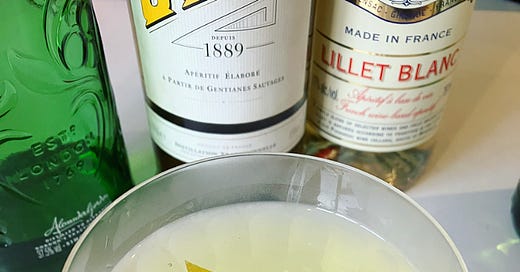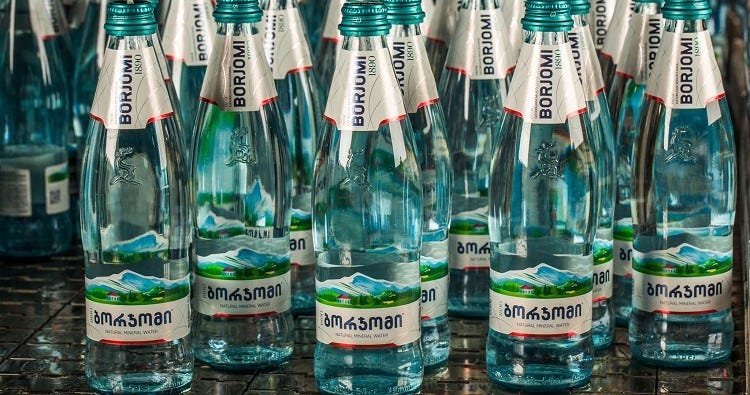~ THE WHITE NEGRONI ~
50ml gin
15ml Lillet Blanc
15ml Suze
Lemon twist
Freeze a cocktail coupe. Now stir all of the ingredient patiently over ice until you hear a slight give. Strain into the frozen glass and garnish with a lemon zest twist - taking care to express the oils over the drink first.
Some White Negroni notes:
1) The recipe also featured in my recent post on Suze, the classic French gentian-based aperitif, a favourite of both Inspector Maigret and Pablo Picasso. If you’re wondering whether to invest in a bottle thereof - or what to do with one you have already purchased - you will find all of the answers here.
2) Lillet Blanc can be subbed, I suppose, for a sweet white vermouth: La Copa Blanco, Cocchi Americano, Mancino Bianco Ambrato, etc. White port at a push? All of these are a bit different in flavour profile, but they perform more or less the same function, which is what you are looking for in a cocktail sub.
3) A grapefruit twist is also good.
THERE’S an article of mine in the Guardian this weekend about water. Specifically, it’s about how the whole business of water (and ice!) has become extremely complicated - and needlessly expensive, considering most of us can hopefully get clean, fresh water from our taps for free.
I looked into the rise of “water sommeliers” in fancy restaurants and took a water tasting course courtesy of the excellent Aqua Amore; I swam around the bewildering ponds of “WaterTok”, and marvelled at the people who seem to think ‘Birthday Cake Water’ is a health food; I surveyed the marketing machine behind the viral $45 Stanley Cup (above); I positively goggled at the New York bar that is importing Kuramoto ice from 5,500 miles away in Japan; and I spoke to Camper English, Instagram’s pre-eminent “ice cube reporter”, and asked him what was going on. He laughed and said: “I don’t think anyone on social media does anything for any actual human reasons anymore.”
I found it all rather fascinating - there is lots to say on each of these phenomena, as regards aspirational consumption, nutritional misonformation, social media marketing, capitalism, and also how to make better cocktails. I didn’t quite get into the water wars that we seem bound to fight in the 21st century. But what interested me overall was this:
Water is, really, the simplest thing we consume - perhaps the only health product that can be said to be truly essential, since without water, life cannot exist. The fact that we have engineered things so that most of us have access to clean, fresh water from our taps is a civilisational miracle - and one that we shouldn’t take for granted. Joan Didion certainly didn’t: “Some of us who live in arid parts of the world think about water with a reverence others might find excessive,” she wrote in her famous 1978 essay, Holy Water. The fact that 25% of the world lacks access to clean fresh water really ought to be our most urgent priority.
But it would appear that there is something in our hyper-modern capitalist mindset that simply cannot countenance a product so free and egalitarian and also, so boring. How can it be that the liquid that is best for you tastes of nothing? So we have to come up with ways of making even tap water aspirational, exclusive - and above all, expensive.
You can read the piece tomorrow - I’ll link to it next week, and hopefully do a proper post on Camper English’s insights on ice too. Suffice to say for now that water is far more interesting than you might imagine.
*
SOMETHING I didn’t get as into as much I’d have liked are the differences between American and European hydration culture. Periodically, on social media, an American traveller to Europe will express themselves amazed and disturbed at the fact that waiters in European restaurants do not, as a rule, place an enormous iced bucket of water on their table the moment they sit down. How are we not all dead? Similarly, the under-icing of drinks in Europe drives many Americans (and occasionally me) to distraction. Do we not know about the great American invention of refrigeration?
But likewise, Europeans are reliably amused and occasionally appalled by American constantly wandering around clutching beverages. The iconic example is the 64oz DOUBLE GULP cup, twice the capacity of a human stomach and - like the AR-15 - a rallying symbol for lovers of American freedom. But everyone seems to walk around with a drink of some kind - coffee, water, juice, soda - and in the absence of a British class system, these beverages form a handy reference guide to social status. At the bottom of the heap is the blue collar and often literally blue-coloured Gatorade. At the pinnacle are the L.A. celebrities and their ultra-aspirational $13 matcha-mint pumpkin seed milk from the Hollywood organic clip joint, Erewhon.
In all cases, there seems to be a very real fear of dying of thirst if one isn’t within 60cm of a sip of liquid at all times; perhaps (as Didion hints) this dates back to pioneer times. But it clearly also links into the more recent, marketing-driven fear of dying of boredom if you are not consuming something at all times - the line between “food” and “entertainment” is more porous than you think. I always wonder: where are all of these people going to the bathroom? Presumably: Starbucks/7-Eleven/Dunkin’ Donuts, where another $5 flagon of ultra-processed liquid will be acquired. In which context, a refillable $45 Stanley Cup suddenly seems quite economical.
Only, here is another peculiar difference that I noticed while living in LA (and particularly when I interviewed the “Beverage King of LA” who had made BILLIONS marketing drinks like Vitamin Water and Vita Coco). A large part of the $1 trillion American beverage industry seems founded on the suppression of the knowledge that there is such a thing as orange squash. There appears to be no cultural equivalent of Robinson’s; no Ribena or Vimto; and none of the interesting cordials and artisanal sirops that are staples in most European pantries. Hence many American consumers seem to be perfectly willing to pay $4.50 for bottles of very squash-esque drinks - which we make at home for pennies.
Indeed, WaterTok - which is predicated on the mixing of revolting e-number-rich syrups and powders with water as if it were some form of revelatory witchcraft - makes almost no sense in a British context. American beverage-carrying habits are catching on here, for sure, but I’m hoping we have some cultural immunity as regards Blue Mermaid Syrup and Birthday Cake Water.
*
Anyway, my favourite water from the tasting was Borjomi from the Georgian Caucasus, which I remembered fondly from my time in St Petersburg as a student - in the former USSR, it is renowned as a hangover cure. It comes gushing out the ground at 40 degrees and it is so packed with minerals it tastes vaguely like drinking Alka-Seltzer. If this were on the no/low ABV menus in more places, I would be very happy.
Although speaking of cultural differences, I was reminded me of a peculiar exchange I had shortly after I arrived in Russia; I was staying with a mother and her two daughters on the outskirts of St Petersburg. I had been told that drinking St Petersburg tap water will give you a stomach ache for 10-20 years, so I had picked up the habit of buying litre bottles of mineral water on the way back from the metro. Only, as I placed the bottle on the table over dinner one evening , my host family looked at me as if I were mad. What’s wrong with drinking water, I asked. “YOU’LL GET FAT!” came the reply. They would not be convinced otherwise.
Further reading: Holy Water by Joan Didion
PLAYLIST
Ah, another playlist-ready theme. Water!
🖊️I am Richard Godwin.
🧋My instructions for sugar syrup, ice, grenadine, orgeat, etc are here.
🧑🏫 My 10 RULES FOR MAKING COCKTAILS are here.
⚗️ My bottle recommendations are here.
📃 The full A-Z recipe archive is here.
➡️ Please find a round up of organisations helping Ukrainians here.
🏥 And here is a list of trusted charities who are helping people in Gaza.







Also interested in your water article. While usually sanitary, tap water in some parts of the US is so ‘hard’ that it has a strong taste at room temperature. Ohio, Indiana, and Arizona - places I have lived - all have this issue for me. The solution is either iced to hide the flavor, filtered, or bottle bought.
Interesting choice to make this more gin forward, and not an equal parts cocktail (à la the classic Negroni). Please discuss.